Air Spaces in Patients Diagnosed with COVID-19 Pneumonitis- A Rare Complication
Article Information
Katarzyna Zimna*, Malgorzata Sobiecka, Katarzyna Lewandowska, Dorota Wyrostkiewicz, Monika Szturmowicz, Ewa Lyzwa, Katarzyna Blasinska, Lilia Jakubowska, Kazimierz Roszkowski-Sliz, Witold Tomkowski
I Department of Lung Diseases, National Tuberculosis and Lung Diseases Research Institute, Warsaw, Poland
*Corresponding Author: Katarzyna Zimna, I Department of Lung Diseases, National Tuberculosis and Lung Diseases Research Institute, Warsaw, Poland.
Received: 09 November 2022; Accepted: 17 November 2022; Published: 01 December 2022
Citation:
Zimna K, Sobiecka M, Lewandowska K, Wyrostkiewicz D, Szturmowicz M, Lyzwa E, Błasinska K, Jakubowska L, RoszkowskiSliz K, Tomkowski W. Air Spaces in Patients Diagnosed with COVID-19 Pneumonitis- A Rare Complication. Journal of Radiology and Clinical Imaging 5 (2022): 71-77.
Share at FacebookAbstract
Introduction: The outbreak of coronavirus disease 2019 (COVID-19) with its overwhelming morbidity and mortality has created a significant challenge for health systems worldwide. Although peripheral ground-glass opacities are the most frequent radiologic feature of COVID-19 described in the literature, late rare complications such as cavitations, pneumatocele, lung cyst, pneumothorax, empyema or hemothorax are occasionally reported.
Methods: We performed a retrospective study and described a group of eight patients, diagnosed with COVID-19, confirmed by the RT-PCR for SARS-CoV-2 and complicated with cystic air spaces. We have searched for studies describing air spaces in subjects with COVID-19 and analyzed the probable pathophysiology of air spaces development.
Results: Among 29 patients diagnosed with COVID-19 pneumonia complicated by air spaces, 19 (65,5%) received surgical intervention. Of note, 25 (86%) were males. Of the 19 interventions, 6 (20,6%) were exclusively chest drain insertions and the rest 13 (45%) required more advanced procedures like VATS or thoracotomy. Most patients did not have any risk factor for such a complication. Among the group- 18 (62%) had no history of smoking, 16 (55%) had no history of previous diseases and only 1 (3%) had the history of COPD. More than half of the patients (18- 62%) did not require mechanical ventilation during initial viral pneumonitis.
Conclusion: According to our observation and reviewed literature, not every pneumatocele or lung cyst requires surgical intervention the decision should be taken on the individual basis. Reasons for surgical intervention included non-resolving pneumothorax, superinfection of pneumatocele, non-responding to antibiotic therapy and hemothorax.
Keywords
COVID-19,Thoracotomy, Pneumatocele,World Health Organisation (WHO)
COVID-19 articles; Thoracotomy articles; Pneumatocele articles; World Health Organisation (WHO) articles
COVID-19 articles COVID-19 Research articles COVID-19 review articles COVID-19 PubMed articles COVID-19 PubMed Central articles COVID-19 2023 articles COVID-19 2024 articles COVID-19 Scopus articles COVID-19 impact factor journals COVID-19 Scopus journals COVID-19 PubMed journals COVID-19 medical journals COVID-19 free journals COVID-19 best journals COVID-19 top journals COVID-19 free medical journals COVID-19 famous journals COVID-19 Google Scholar indexed journals Thoracotomy articles Thoracotomy Research articles Thoracotomy review articles Thoracotomy PubMed articles Thoracotomy PubMed Central articles Thoracotomy 2023 articles Thoracotomy 2024 articles Thoracotomy Scopus articles Thoracotomy impact factor journals Thoracotomy Scopus journals Thoracotomy PubMed journals Thoracotomy medical journals Thoracotomy free journals Thoracotomy best journals Thoracotomy top journals Thoracotomy free medical journals Thoracotomy famous journals Thoracotomy Google Scholar indexed journals Pneumatocele articles Pneumatocele Research articles Pneumatocele review articles Pneumatocele PubMed articles Pneumatocele PubMed Central articles Pneumatocele 2023 articles Pneumatocele 2024 articles Pneumatocele Scopus articles Pneumatocele impact factor journals Pneumatocele Scopus journals Pneumatocele PubMed journals Pneumatocele medical journals Pneumatocele free journals Pneumatocele best journals Pneumatocele top journals Pneumatocele free medical journals Pneumatocele famous journals Pneumatocele Google Scholar indexed journals World Health Organisation articles World Health Organisation Research articles World Health Organisation review articles World Health Organisation PubMed articles World Health Organisation PubMed Central articles World Health Organisation 2023 articles World Health Organisation 2024 articles World Health Organisation Scopus articles World Health Organisation impact factor journals World Health Organisation Scopus journals World Health Organisation PubMed journals World Health Organisation medical journals World Health Organisation free journals World Health Organisation best journals World Health Organisation top journals World Health Organisation free medical journals World Health Organisation famous journals World Health Organisation Google Scholar indexed journals Acute Respiratory Distress Syndrome articles Acute Respiratory Distress Syndrome Research articles Acute Respiratory Distress Syndrome review articles Acute Respiratory Distress Syndrome PubMed articles Acute Respiratory Distress Syndrome PubMed Central articles Acute Respiratory Distress Syndrome 2023 articles Acute Respiratory Distress Syndrome 2024 articles Acute Respiratory Distress Syndrome Scopus articles Acute Respiratory Distress Syndrome impact factor journals Acute Respiratory Distress Syndrome Scopus journals Acute Respiratory Distress Syndrome PubMed journals Acute Respiratory Distress Syndrome medical journals Acute Respiratory Distress Syndrome free journals Acute Respiratory Distress Syndrome best journals Acute Respiratory Distress Syndrome top journals Acute Respiratory Distress Syndrome free medical journals Acute Respiratory Distress Syndrome famous journals Acute Respiratory Distress Syndrome Google Scholar indexed journals Chronic Obstructive Pulmonary Disease articles Chronic Obstructive Pulmonary Disease Research articles Chronic Obstructive Pulmonary Disease review articles Chronic Obstructive Pulmonary Disease PubMed articles Chronic Obstructive Pulmonary Disease PubMed Central articles Chronic Obstructive Pulmonary Disease 2023 articles Chronic Obstructive Pulmonary Disease 2024 articles Chronic Obstructive Pulmonary Disease Scopus articles Chronic Obstructive Pulmonary Disease impact factor journals Chronic Obstructive Pulmonary Disease Scopus journals Chronic Obstructive Pulmonary Disease PubMed journals Chronic Obstructive Pulmonary Disease medical journals Chronic Obstructive Pulmonary Disease free journals Chronic Obstructive Pulmonary Disease best journals Chronic Obstructive Pulmonary Disease top journals Chronic Obstructive Pulmonary Disease free medical journals Chronic Obstructive Pulmonary Disease famous journals Chronic Obstructive Pulmonary Disease Google Scholar indexed journals Computed Tomography Pulmonary Angiography articles Computed Tomography Pulmonary Angiography Research articles Computed Tomography Pulmonary Angiography review articles Computed Tomography Pulmonary Angiography PubMed articles Computed Tomography Pulmonary Angiography PubMed Central articles Computed Tomography Pulmonary Angiography 2023 articles Computed Tomography Pulmonary Angiography 2024 articles Computed Tomography Pulmonary Angiography Scopus articles Computed Tomography Pulmonary Angiography impact factor journals Computed Tomography Pulmonary Angiography Scopus journals Computed Tomography Pulmonary Angiography PubMed journals Computed Tomography Pulmonary Angiography medical journals Computed Tomography Pulmonary Angiography free journals Computed Tomography Pulmonary Angiography best journals Computed Tomography Pulmonary Angiography top journals Computed Tomography Pulmonary Angiography free medical journals Computed Tomography Pulmonary Angiography famous journals Computed Tomography Pulmonary Angiography Google Scholar indexed journals enous-Venous Extracorporeal Membrane Oxygenation articles enous-Venous Extracorporeal Membrane Oxygenation Research articles enous-Venous Extracorporeal Membrane Oxygenation review articles enous-Venous Extracorporeal Membrane Oxygenation PubMed articles enous-Venous Extracorporeal Membrane Oxygenation PubMed Central articles enous-Venous Extracorporeal Membrane Oxygenation 2023 articles enous-Venous Extracorporeal Membrane Oxygenation 2024 articles enous-Venous Extracorporeal Membrane Oxygenation Scopus articles enous-Venous Extracorporeal Membrane Oxygenation impact factor journals enous-Venous Extracorporeal Membrane Oxygenation Scopus journals enous-Venous Extracorporeal Membrane Oxygenation PubMed journals enous-Venous Extracorporeal Membrane Oxygenation medical journals enous-Venous Extracorporeal Membrane Oxygenation free journals enous-Venous Extracorporeal Membrane Oxygenation best journals enous-Venous Extracorporeal Membrane Oxygenation top journals enous-Venous Extracorporeal Membrane Oxygenation free medical journals enous-Venous Extracorporeal Membrane Oxygenation famous journals enous-Venous Extracorporeal Membrane Oxygenation Google Scholar indexed journals Low Molecular Weight Heparin articles Low Molecular Weight Heparin Research articles Low Molecular Weight Heparin review articles Low Molecular Weight Heparin PubMed articles Low Molecular Weight Heparin PubMed Central articles Low Molecular Weight Heparin 2023 articles Low Molecular Weight Heparin 2024 articles Low Molecular Weight Heparin Scopus articles Low Molecular Weight Heparin impact factor journals Low Molecular Weight Heparin Scopus journals Low Molecular Weight Heparin PubMed journals Low Molecular Weight Heparin medical journals Low Molecular Weight Heparin free journals Low Molecular Weight Heparin best journals Low Molecular Weight Heparin top journals Low Molecular Weight Heparin free medical journals Low Molecular Weight Heparin famous journals Low Molecular Weight Heparin Google Scholar indexed journals Disseminated Intravascular Coagulation articles Disseminated Intravascular Coagulation Research articles Disseminated Intravascular Coagulation review articles Disseminated Intravascular Coagulation PubMed articles Disseminated Intravascular Coagulation PubMed Central articles Disseminated Intravascular Coagulation 2023 articles Disseminated Intravascular Coagulation 2024 articles Disseminated Intravascular Coagulation Scopus articles Disseminated Intravascular Coagulation impact factor journals Disseminated Intravascular Coagulation Scopus journals Disseminated Intravascular Coagulation PubMed journals Disseminated Intravascular Coagulation medical journals Disseminated Intravascular Coagulation free journals Disseminated Intravascular Coagulation best journals Disseminated Intravascular Coagulation top journals Disseminated Intravascular Coagulation free medical journals Disseminated Intravascular Coagulation famous journals Disseminated Intravascular Coagulation Google Scholar indexed journals
Article Details
Abbreviations:
ARDS- Acute Respiratory Distress Syndrome; CM- Centimeter; COPD- Chronic Obstructive Pulmonary Disease; COVID-19- Coronavirus Disease 2019; CPAP- Continuous Positive Airway Pressure; CRP- C-Reactive Protein; CT- Computed Tomography; CTPA- Computed Tomography Pulmonary Angiography; DIC- Disseminated Intravascular Coagulation; ESBL- Extended Spectrum Beta-Lactamase; HFO2T- High-Flow Oxygen Therapy; ICU- Intensive Care Unit; l/min- Liter Per Minute; LMWH- Low Molecular Weight Heparin; ML- Milliliter; NIC- Non-Invasive Ventilation; NT-proBNP- N-Terminal Prohormone of Brain Natriuretic Peptide; RT-PCR- Reverse Transcription Polymerase Chain Reaction; Severe Acute Respiratory Syndrome Coronavirus 2 (SARS-CoV-2); VATS- Video-Assisted Thoracic Surgery; VV-ECMO- Venous-Venous Extracorporeal Membrane Oxygenation; WHO- World Health Organisation
1. Introduction
Coronavirus disease 2019 (COVID-19) caused by the severe acute respiratory syndrome coronavirus 2 (SARS-CoV-2) was initially reported to the World Health Organisation (WHO) on December 31st, 2019. As the cases of disease increased rapidly, WHO declared COVID-19 as a global pandemic [1]. Since then more than 489 million cases and more than 6 million deaths have been reported worldwide [2]. Mild to moderate cases with the clinical symptoms such as fever, dry cough, myalgia and fatigue could be community-managed. However, severe cases of viral pneumonia, which may be accompanied by Acute Respiratory Distress Syndrome (ARDS), require hospitalization and mechanical ventilation in the Intensive Care Unit (ICU) [1,3]. The most frequent radiological manifestations described in the literature are peripheral ground-glass opacities, interlobular septal and pleural thickening, crazy paving pattern and consolidations. Rare radiological presentations include: nodules, cystic changes, bronchiectasis, lymphadenopathy and pleural effusion [4]. Long-term severe thoracic complications, such as pneumatocele, lung cysts, pneumothorax, empyema or hemothorax were mostly described in the literature as case reports and case series [5-17]. We analyzed probable pathophysiology and outcome in patients with pneumatocele and lung cysts as pulmonary complication of COVID-19 supported by recent literature review.
2. Methods
From September 2020 to December 2021, a retrospective study was performed in patients admitted with a diagnosis of air space after SARS-CoV2 infection. Clinical and demographic variables were collected, including comorbidities, smoking history, laboratory results, infection and surgical history. We described 8 consecutive cases that exemplify uncommon complication of COVID-19 pneumonitis. Typical radiological manifestations like peripheral ground-glass opacities, interlobular septal and pleural thickening as well as consolidations have been described at the onset of the pandemic [3]. However, cystic abnormalities such as pneumatocele, cystic air spaces and cavitations were rarely reported. We have searched the PubMed for studies describing air spaces in subjects with COVID-19 using the free text term: “pneumatocele + lung cyst + COVID-19”. The search found 13 citations (Table 2). Together with our 8 cases, we analyzed the probable pathophysiology of air spaces development. Data collection was performed on January 12th, 2022. Our cases constituted 27,5% of the group. Our patients, during recovery from COVID-19 (4-6 weeks after first onset of the symptoms) presented with worsening of the clinical condition, which required further investigation. At date there is no dependable management algorithm for such pathology.
3. Results
Among these 29 patients diagnosed with COVID-19 pneumonia complicated by air spaces, 19 (65,5%) received surgical intervention. Of note, 25 (86%) were males. Of the 19 interventions, 6 (20,6%) were exclusively chest drain insertions and the rest 13 (45%) required more advanced procedures like VATS or thoracotomy. Most of the above described patients did not have any risk factor for such a complication. Among the group- 18 (62%) had no history of smoking, 16 (55%) had no history of previous diseases and only 1 (3%) had the history of COPD. More than half of the patients (18-62%) did not require mechanical ventilation during initial viral pneumonitis. Reasons for surgical intervention include continued air leak, non-resolving pneumothorax in spite of drain insertion, superinfection of pneumatocele, non-responding to antibiotic therapy, with ongoing sepsis, progressive enlargement of the cyst with normal lung compression or hemothorax. The results of pathological examinations were available in 11 of the patients, who underwent a surgical procedure (Figures 1-8).
Table 1. Summary of our cases with the dimensions of pneumatocele.
Table 2. Recent literature review.
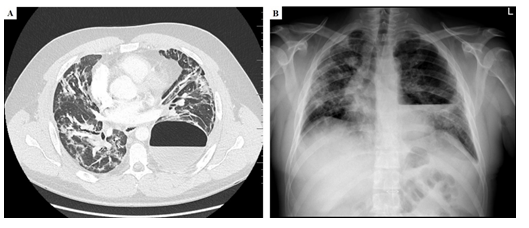
Figure 1: A- Chest CT scan, axial view delineating extend of the lung cyst with air-fluid level B- Chest X-ray showing left side air cyst with air-fluid level.
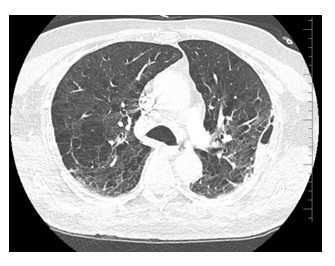
Figure 2: A chest CT scan showing an oval air space.
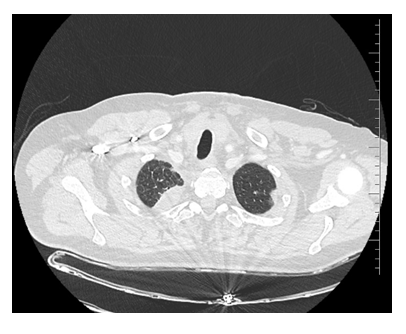
Figure 3: An axial CT scan demonstrating a superinfected lung cyst in right apical segment.
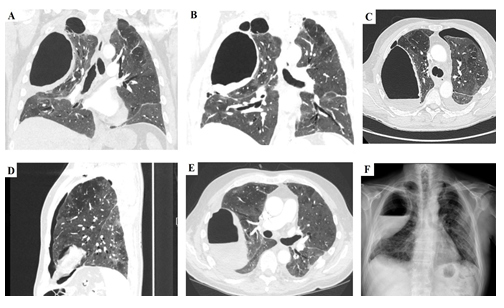
Figure 4: (A,B) - A coronal chest CT scans demonstrating a complex structure of right-sided lung cyst (C) - An axial and (D) - sagittal chest CT scan showing left-sided pneumothorax (E) - An axial chest CT scan presenting air-fluid level in the lung cyst (F) - A chest X-ray showing thickening of the cyst wall and fluid level
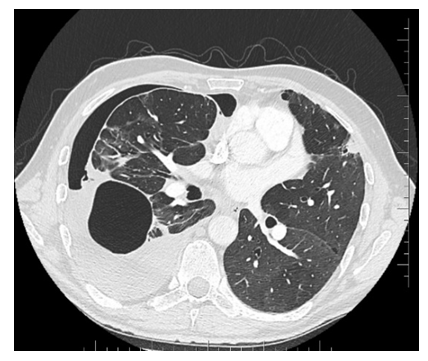
Figure 5: An axial CT scan showing right sided pneumothorax, right sided pleural effusion and a pneumatocele.
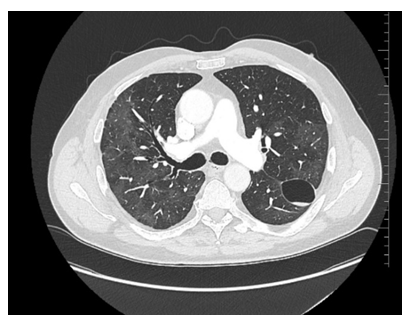
Figure 6: An axial CT scan demonstrating a lung cyst in the left lung.

Figure 7: (A) - An axial chest CT scan presenting a pneumatocele in the right lung with a slightly thickened wall (B) - A cross-sectional chest CT scan demonstrating two pneumatocele in the right lung (C) - An axial chest CT scan presenting the second small pneumatocele in the right lung
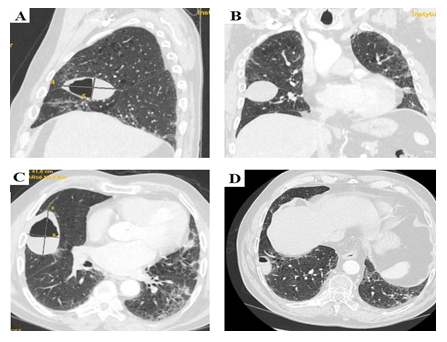
Figure 8: A- A sagittal B- coronal and C- axial CT scan presenting a large cyst in the right lung and D- small pneumatocele in the right lung.
4. Discussion
According to the literature, including Fleishner Society Glossary [19], pneumatoceles are defined as thin-walled air-filled cysts in the lung interstitium. They often contain air-fluid level and may vary in size. Most cases of pneumatoceles are described in children or young adolescents. Pneumatocele can result from infection with Streptococcus pneumoniae, Staphylococcus aureus, Pneumocystis jiroveci, Pseudomonas aeruginosa, Klebsiella pneumoniae, adenovirus, Mycobacterium tuberculosis, Proteus mirabilis, Acinetobacter, Hemophilus influenzae B type, Bacteroid species, or noninfectious process like barotrauma from Continuous Positive Airway Pressure (CPAP) during mechanical ventilation. [20-22]. A lung cyst is described as a round parenchymal lucency with a well-defined interface with normal lung, surrounded by an epithelial or fibrous wall of variable thickness (<2mm). The both terms are used in the literature to described air spaces in COVID-19 patients. The pathophysiology of these cystic lesions in COVID-19 is not well studied, although some potential mechanisms are described. Regarding recent literature, one theory explaining the process of the development of pneumatocele, according to Manenti et al. [23] is ischemia related. Inflammatory cells infiltration and exudate lead to occlusion of alveoli and respiratory bronchioles, causing a “ball-valve mechanism”- the air is allowed to enter the cystic space but not to leave it. Presence of microthrombi in pulmonary capillaries, which are affected by endothelithis, causes ischemia, necrosis and inflammation, which lead to alveolar wall damage and accumulation of air within the lung parenchyma. Consequently, the trapped air could dissect the parenchymal tissue to the pleura or mediastinum- generating pneumothorax or pneumomediastinum or to the subpleural space, causing pneumatocele. In some of the pathological examinations of lung tissue (Table 1 and 2), diffuse necrosis, hemorrhage and thrombi are described. Nevertheless, most frequent findings are a wide range of lung interstitial inflammation with signs of organizing pneumonia, fibrosis and, in some cases, metaplasia, resulting in increased susceptibility of the lung parenchyma to damage. Supplementary factor is barotrauma, which increases intra-alveaolar pressure and leads to alveolar wall rupture [5-7,21,23]. Continuous positive airway pressure during mechanical ventilation or non-invasive ventilation may cause injury, lung tissue disruption and enlargement of air space. However, more than 50% of the patients mentioned in our review required oxygen support without the necessity of invasive ventilation. Most pneumatoceles that are not COVID-19 related resolve within a few weeks to 12 months with no additional intervention. Probably uncomplicated pneumatocele (thin-walled, with no signs of progressive enlargement) in COVID-19 patients would also resolve spontaneously. The most frequent complications of pneumatocele described in the literature are rupture resulting in pneumothorax or pneumomediastinum, superinfection or haemothorax. Among patients described in the literature, diagnosed with COVID-19 pneumonia complicated by air spaces, after unsuccessful conservative treatment, surgical intervention was necessary. Part of the patients showed clinical and radiological improvement under conservative treatment and could be discharged. Hence, CT scanning should be repeated in patients with newly discovered pneumatocele after recovering from COVID-19, which may prevent to overlook further complications. Conservative management or surgical intervention in those complications should be decided during multidisciplinary discussion (thoracic surgeon, respiratory physician, intensive care specialist) taking into consideration the patient’s clinical status, radiological manifestation and expected outcome. Particular difficulties concern the proper interpretation of CT scans in patients with pneumatocele. The CT images are deceptively similar to pleural empyema. In these cases, a precise radiological diagnosis determines the appropriate surgical therapy and outcome of treatment.
5. Conclusions
The case series and systemic review of the literature provide a few learning points.
-Not every infected pneumatocele or lung cyst requires surgical intervention
-Persistent air-leak, associated pneumothorax and haemothorax suggest more urgent surgical intervention
-Secondary infection of the pneumatocele not-responding to extended antibiotic therapy is a potential life threatening condition and should be considered for surgical resection. Prompt surgical approach may be lifesaving in patients in the critical clinical stage
-In patients with newly discovered pneumatocele after recovering from COVID-19, repeated imaging in 4-6 weeks may prevent further complications
-Second imaging in a prone position could help to distinguish a pneumothorax from a pneumatocele
References
- Majumder J, Minko T. Recent Developments on Therapeutic and Diagnostic Approaches for COVID-19. AAPS 23 (2021).
- World Health Organisation. Coronavirus disease 2019. Situation Report.
- Mølhave M, Agergaard J, Wejse C. Clinical Management of COVID-19 Patients – An Update. Seminars in Nuclear Medicine 52 (2022): 4-10.
- Shi H, Han X, Jiang N, et al. Radiological findings from 81 patients with COVID-19 pneumonia in Wuhan, China: a descriptive study. The Lancet Infectious Diseases 20 (2020): 425-434.
- Hamad AMM, El-Saka HA. Post COVID-19 large pneumatocele: clinical and pathological perspectives, Interac Cardiovasc Thorac Surg 33 (2021): 322-324.
- Kunadharaju R, Monegro A. COVID-19 presenting as pneumatoceles and spontaneus cavitary lesion as a late complication. BMJ Case Rep 14 (2021): e246516.
- Castiglioni M, Pelosi G, Meroni A, et al. Surgical Resections of superinfected pneumatoceles in a COVID-19 patient, Ann Thorac Surg 111(2021): e23-25.
- Chang SH, Chen D, Paone D, et al. Thoracic surgery outcomes for patients with Coronavirus Disease 2019. J Thorac Cardiovasc Surg 162 (2021): 1654-1664.
- Sugimoto H, Era Y, Sugimoto K. Pneumatocele after recovering from COVID-19, BMJ Case Reports CP 14 (2021): e242729.
- Hampson F, Salih W, Jennifer Helm. Development of a Large Pneumatocele in a Patient Recovering from COVID-19 Pneumonitis. EJCRIM 8 (2021).
- Capleton P, Ricketts W, Lau K, et al. Pneumothorax and pneumatocele formation in a patient with COVID-19: a Case Report; SN Compr Clin Med (2020).
- Mallick T, Dinesh A, Engdahl R, et al. COVID-19 Complicated by spontaneous Pneumothorax, Cureus 121 (2020): e9104.
- McCann C, Shoeib M, Rashid MI, et al. Pneumatocele formation following COVID-19 pneumonia. Is there a role for surgical intervention? Asian Cardiovascular and Thoracic Annals (2021).
- Sanivarapu RR, Farraj K, Sayedy N, et al. Rapidly developing large pneumatocele and spontaneous pneumothorax in SARS-CoV-2 infection. Respir Med Case Rep 31 (2020): 101303.
- Jamal W, Shariff M, Sayeed A, et al. Post-COVID-19 pneumonia pneumatoceles: a case report. European Clinical Respiratory Journal 9 (2022): 1.
- Brahmbhatt N, Tamimi O, Ellison H, et al. Pneumatocele and cysts in a patient with severe acute respiratory syndrome coronavirus 2 infection. JTCVS Tech 4 (2020): 353-355.
- Natarajan P, Skidmore J, Aduroja O, et al. Bilateral pneumatoceles resulting in spontaneous bilateral pneumothoraces and secondary infection in a previously healthy man with COVID-19. Proc (Bayl Univ Med Cent) 34 (2021): 590-592.
- Jolobe OMP. Air leaks, pneumatoceles, and air spaces in Covid-19 pneumonia. The American Journal of Emergency Medicine 46 (2021): 785.
- Hansell D, Bankier A, MacMahon H, et al. Fleischner Society: Glossary of Terms for Thoracic Imaging. Radiology 246 (2008).
- Jamil A, Kasi A. Pneumatocele. In: StatPearls [Internet]. Treasure Island (FL): StatPearls Publishing (2022).
- Quigley MJ, Fraser RS. Pulmonary Pneumatocele: Pathology and pathogenesis. AJR 150 (1988): 1275-1277.
- Frick AE, Ankersmit HJ, Simonitsch-Klupp I, et al. Difficulties in the differential diagnosis of large solitary pulmonary cysts, Interactive CardioVascular and Thoracic Surgery (2021).
- Manenti A, Roncati L, Melegari G. Deepening pathology of SARS-CoV-2 pneumonia explains lung ventilation complications. The Annals of Thoracic Surgery (2021).
